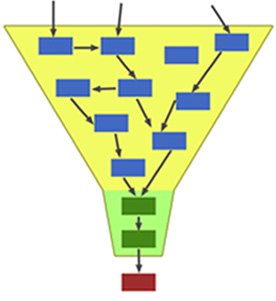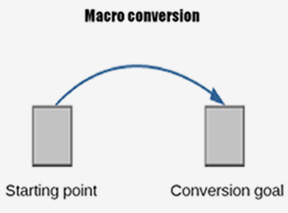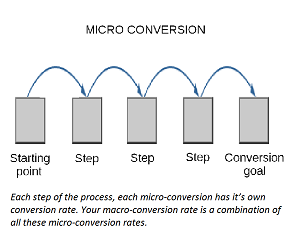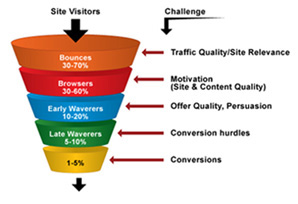The purchase funnel
Introduction To
Ecommerce Customer Acquisition
2The Psychology Behind The Purchase Funnel

One of the key concepts of ecommerce is what’s known as the “purchase funnel” or “sales funnel”. Understanding this concept gives you a good overview of the customer acquisition process as it occurs online.
In online shopping the purchase process includes several steps visitors must complete before they submit an order and you acquire a customer. Unfortunately, visitors can abandon the process at any step and leave a site.
The figure illustrates the purchase funnel and indicates the purchasing process online. Each rectangle represents a step in the process. The red rectangle at the bottom represents the conversion goal, which indicates you’ve acquired a new customer. Typically this is the “thank you page”, where you thank your customers for making their purchase. Obviously, a visitor can only reach this page if they have actually placed an order, so your goal is to have as many visitors as possible reach this step.
There is a reason for the funnel shape: many visitors start by reading the pages on your site, or your ads, and you “funnel” those visitors towards a purchase. Along the way, some visitors will decide not to make a purchase. At the end of the funnel are the small number of customers you acquire from each set of visitors to your site.
2.1. Macro-conversions

The number of visitors compared to the number of customers you acquire is the conversion rate of your store. As we mentioned earlier, this is one of the most important indices in measuring the efficiency of an online store. This is measured every 100 visitors, so 2 customers who make a purchase out of 100 visitors is a 2% conversion rate.
However, the conversion rate by itself is just a number and it doesn’t tell you what is good or bad about your online store, or what to fix. For a visitor to finally make a purchase, they must pass through a number of pages, place at least one product in the cart, then provide shipping information and indicate their method of payment. Only after these step are they allowed to click on the “order” button. Clicking on the “order” button is the macro-conversion, it’s the big win.
2.2. Micro-conversions

As we see from the “purchase funnel”, there are plenty of steps along the way to a visitor making a purchase and becoming a customer. This also means there are plenty of steps along the way where a visitor might change their mind and not make a purchase. For instance:
- People who browse your site but don’t add any items to their cart.
- People who add items to their cart but don’t add their shipping information.
- People who add items to their cart, enter their shipping information, but don’t click on Submit.
In order to achieve a macro-conversion, your customers must complete several smaller steps along the way. These smaller steps are micro-conversions.
2.3. A real life scenario
Let’s look at a real-life scenario with four micro-conversions:
- Viewing a product
- Adding a product to the cart
- Providing a shipping address and payment information
- Placing the order
For the sake of simplicity, let’s assume that visitors arrive at the homepage of your online store, and exactly 100 visitors arrive per day. If only half of them look at a product, then the homepage conversion rate is 50%. This means you have already lost half of your visitors, since they have not moved on from the homepage, have not looked at a single product page, and have not added anything to the cart.
Another way to look at this is that 50% of your visitors have “bounced” off the homepage, which is not an unusual rate. The home page bounce rate is 15-20% for a good online store, and it can be 70-80% for a really bad one. The bounce rate is one of the most important indices of an online store’s homepage, and more generally, of any landing page.
So, only 50 people have looked at a product, which is the first micro-conversion. Let’s assume that only five people out of this 50, or every tenth person, have added anything to their cart. In this case, the micro-conversion rate of the product page is 10%.
At this point, only five people have reached the step where they enter their shipping and payment information. If three of these five visitors provide their information and two do not, then the micro-conversion rate of this page is 60%, leaving us with 3 visitors who can in fact place an order, and if two of these visitors finally click on the order button, because one may still change their mind even at this step, then the micro-conversion rate of the order page is 66%.
Here is a table that shows the entire process and micro-conversion rates for each step along the way:
| Home Page |
Product Page |
Cart | Ordering | Thank you page |
|
|---|---|---|---|---|---|
| Number of visitors who reached this step |
100 | 50 | 5 | 3 | 2 |
| Micro-conversion rate of the step |
50% | 10% | 60% | 66% | N/A |
As you can see, the four micro-conversions combined provide the macro-conversion, which we can also calculate as the product of the four micro-conversions. The result is 2%, because in the end, only 2 out of 100 people have placed an order.
Small differences can really add up quick. Let’s look at what happens if you change, for example, the second of the four micro-conversions, and raise it to 20%, indicating that twice as many people add your products to their cart from the product page. You might improve this micro-conversion from 10% to 20% by lowering your prices or providing better photos and descriptions. Let’s take a look at what happens when you do:
| Home Page |
Product Page |
Cart | Ordering | Thank you page |
|
|---|---|---|---|---|---|
| Number of visitors who reached this step |
100 | 50 | 10 | 6 | 4 |
| Micro-conversion rate of the step |
50% | 20% | 60% | 66% | N/A |
It’s still only 50 people that continue to the product page, but 10 people add items to their cart compared to 5. As a result 6 people provide their shipping and payment information instead of 3, and finally, 4 people place an order instead of 2.
2.4. Conversion Optimization

As you can see, when you double your micro-conversion rate this also doubles your macro-conversion rate. In our example, the macro-conversion rate increased from 2% to 4%! Changing one page in the chain affects the entire process in direct proportion.
While one page can improve your macro-conversion rate, the opposite is also true, a weak link can drag the entire process down. Regardless of how good the other pages are, a poor micro-conversion rate in one step of the process will lead to a poor overall macro-conversion rate. The reason for poor performance on many ecommerce sites is often a weak link. The upside is that finding the weak link and fixing it can result in spectacular improvements.
Finding the weak links and fixing them, improving your micro-conversion rate and macro-conversion rate through testing and optimization is known as conversion optimization. And with an online store, there’s always room for improvement!
The first step in conversion optimization is to measure what percentage of visitors reach specific milestones during the purchase process and at which point you lose your customers. Once you find the weak points, you can concentrate on improving them and optimizing your customer acquisition process by optimizing your conversion rates.
Conversion paths that indicate what ratio of visitors “complete” specific steps can be set in Google Analytics. This makes it easy to find weak links on your site.
2.5. Onsite retargeting
Just as onsite retargeting can be used to capture contact information, you can also use it as a tool for conversion optimization. Onsite Retargeting works by monitoring the behavior of your visitors, and when their behavior indicates they are ready for some additional message, the message is displayed to them, usually in a popup window or overlay.
This is really helpful for improving weak links on your site. Sometimes a poorly performing page may need a different message or different approach. This is where Onsite Retargeting comes to the rescue! You can monitor visitor behavior, and if your primary message is not working, you can present a second one.
Basically you can double your opportunities for success with Onsite Retargeting. And as we’ve seen, doubling your micro-conversion rate in one step of the process will double your macro-conversion rate.






